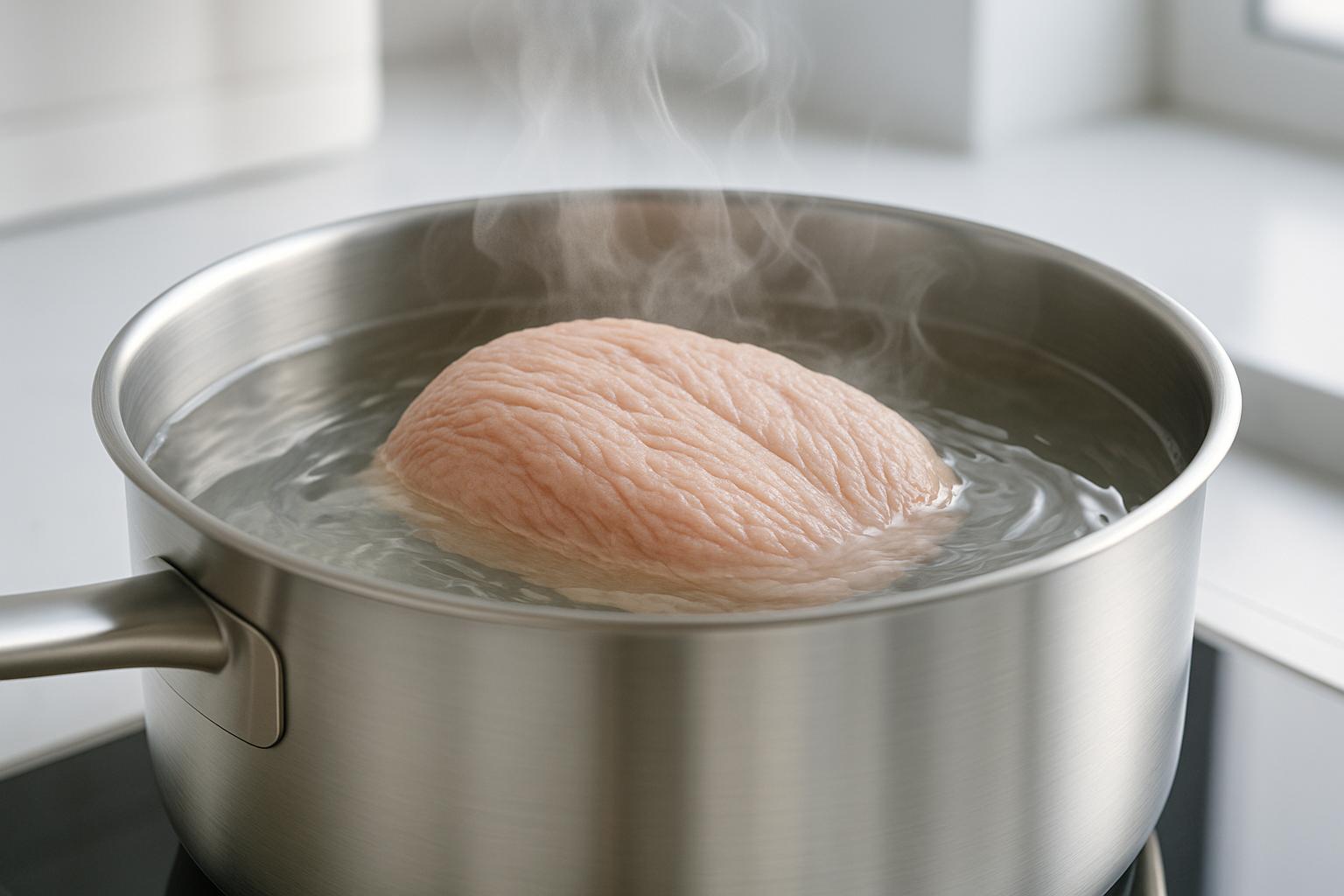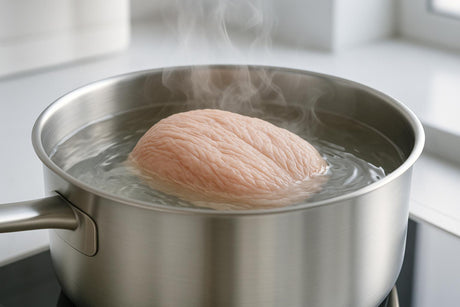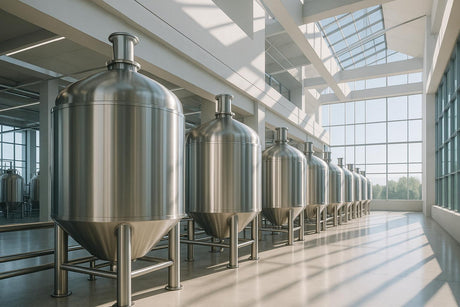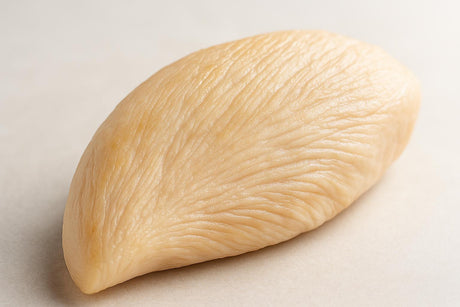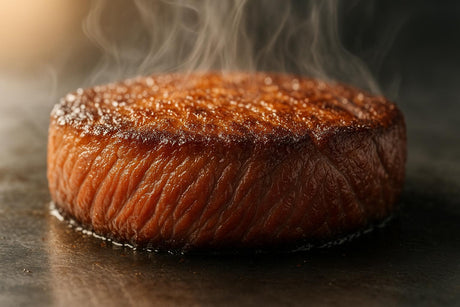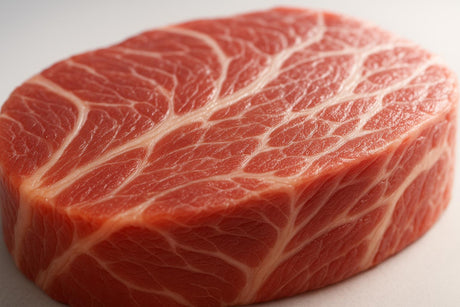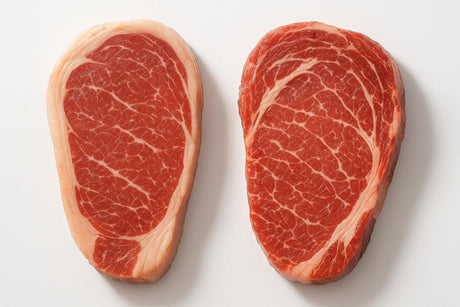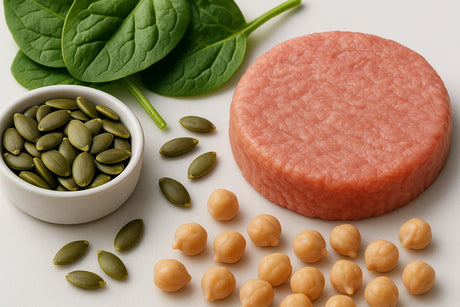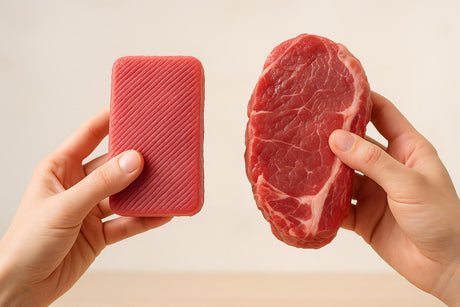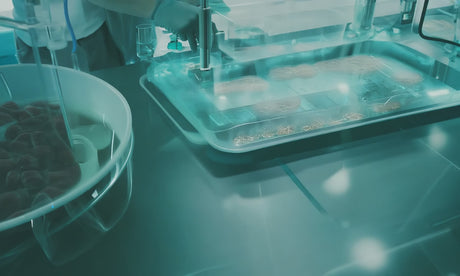Boiling cultivated meat can work, but it requires adjustments to traditional methods. Unlike conventional meat, cultivated meat lacks connective tissue, making it more prone to texture changes like becoming mushy or overly soft when boiled. Key findings from recent tests show:
- Boiling Temperature: Keep water between 85°C and 95°C to avoid overcooking.
- Cooking Time: Shorter boiling times (10–20 minutes) work best.
- Texture Differences: Cultivated meat often has a softer, pâté-like texture when boiled.
- Preparation Tips: Brining or marinating helps retain moisture and improve flavour.
For better results, combine boiling with a quick sear to add texture and enhance flavour. While boiling is simple, other methods like pan-frying or sous-vide may deliver better results for certain dishes.
How Boiling Changes Meat Texture
Boiling has a profound impact on meat texture, and when it comes to cultivated meat, its unique composition makes understanding this process even more important.
What Happens When You Boil Meat
Boiling meat triggers a process called protein denaturation. Essentially, heat causes proteins to unravel and muscle fibres to firm up - think of how a raw egg white solidifies when cooked. As the proteins contract, they squeeze out moisture, which can lead to tough, dry meat if the temperature exceeds 70°C.
However, there's an exception: collagen, the connective tissue found in tougher cuts. At boiling temperatures, collagen slowly transforms into gelatin, making these cuts more tender if cooked long enough. The tricky part is finding the balance. Overboiling or cooking too aggressively can leave you with meat that's dry and chewy. This delicate process is especially relevant when considering how cultivated meat, with its engineered structure, responds differently to boiling.
Conventional Meat vs Cultivated Meat Texture
Here’s where it gets interesting. While conventional and cultivated meats share core components like muscle proteins and fat, they behave differently under heat.
Cultivated meat is specifically designed with tailored fat and protein compositions, which means its reaction to boiling varies. Conventional meat has a naturally complex structure, with connective tissue, marbling, and diverse muscle fibres that create its familiar texture.
Cultivated meat, on the other hand, often lacks this intricate connective tissue. Its engineered make-up typically includes less connective tissue and a different fat distribution, resulting in a softer, more uniform texture when boiled. This can make cultivated meat more prone to becoming mushy or lacking the fibrous chew associated with traditional cuts.
Taste tests have highlighted these differences. Boiled cultivated chicken and beef often have a softer, pâté-like texture compared to their conventional counterparts. For example, cultivated chicken is tender but misses the stringy texture you'd expect from boiled chicken breast. Without natural connective tissue, cultivated meat doesn’t benefit from the tenderisation that occurs when collagen breaks down in conventional tougher cuts during long, slow boiling. Its muscle fibres also react differently, affecting both texture and juiciness.
This engineered structure also makes cultivated meat more sensitive to overcooking. It tends to cook faster and can become overly tender or even fall apart more quickly because of its unique cellular structure. As a result, traditional boiling methods often need to be adapted for cultivated alternatives.
These differences explain why some early adopters have had mixed results when using conventional boiling techniques on cultivated meat. The silver lining? With the right adjustments, boiling can still be a reliable way to cook these innovative products.
Problems with Boiling Cultivated Meat
Cultivated Meat, while an exciting development, presents unique challenges when it comes to boiling. These difficulties highlight why traditional boiling techniques often fail to produce satisfying results with these products.
Common Texture Issues
Boiling Cultivated Meat often results in a texture that's tough, rubbery, and dry, lacking the springiness that makes meat enjoyable.
The toughness and rubbery feel are particularly noticeable. Unlike conventional meat, which can become tender when boiled properly, Cultivated Meat tends to develop a dense, chewy texture that many find unappealing. In early consumer trials, participants frequently described boiled Cultivated Meat chicken breast as "chewy" and "less juicy" compared to versions cooked using other methods like pan-frying.
Another striking issue is the absence of that characteristic bounce or springiness found in well-cooked meat. Instead of delivering the satisfying resistance that meat lovers expect, boiled Cultivated Meat can feel flat and lifeless, missing that essential texture that makes eating meat so enjoyable.
These challenges are rooted in the fundamental structural differences of Cultivated Meat, as explained below.
Why Cultivated Meat Reacts Differently
The texture problems with boiling Cultivated Meat can be traced back to its engineered structure, which sets it apart from conventional meat.
One key difference is its low collagen content, which limits the formation of gelatin during cooking. This means Cultivated Meat doesn't naturally tenderise over time when boiled. Instead, its proteins contract and firm up, resulting in a rubbery consistency.
Additionally, its uniform fat distribution disrupts natural basting, leading to uneven moisture retention. This can cause some parts of the meat to dry out while others remain overly fatty, creating an inconsistent eating experience.
Another challenge is its uniform fibre structure, which makes Cultivated Meat highly sensitive to heat. Proteins contract rapidly, making it prone to overcooking and leaving the texture overly uniform and less appealing.
These structural differences mean that traditional boiling methods, which work well for collagen-rich conventional cuts, are not suitable for Cultivated Meat. A tailored approach is essential to address these unique challenges and unlock its potential in boiled dishes.
How to Boil Cultivated Meat Properly
Boiling Cultivated Meat comes with its own set of challenges, but with the right techniques, you can achieve tender and flavourful results. This modern protein requires gentler handling and precise cooking compared to traditional meat.
Time and Temperature Matter
When boiling Cultivated Meat, aim for a gentle simmer - keep the water temperature between 85°C and 95°C. Avoid a rolling boil, as it can make the meat tough and dry. Heat the meat until its internal temperature reaches 70–75°C for safe consumption and optimal texture [1].
Boiling times should stay relatively short, usually between 10 and 20 minutes, depending on the thickness of the cut. Unlike conventional meat, Cultivated Meat doesn’t have connective tissues to lock in moisture during long cooking times. Use the fork-tender test to check doneness: if the meat is easy to pierce and has reached the target temperature, it’s ready to come off the heat.
Prepping the Meat for Better Results
For the best outcome, marinate or brine the meat for at least 30 minutes before cooking. Brining allows a salt solution to penetrate the fibres, helping the meat hold onto moisture during boiling. If marinating, focus on ingredients that lock in moisture - use acidic marinades sparingly, as Cultivated Meat’s even structure is more sensitive to acid than traditional cuts.
To add depth of flavour, toss aromatics like onion, garlic, thyme, or bay leaves directly into the boiling water. These simple additions can elevate the taste without overwhelming the meat’s natural qualities.
Combine Boiling with Other Techniques
For a more dynamic texture and flavour, follow up boiling with a high-heat finishing method. Once boiled, sear the meat for 1–2 minutes per side to create a crispy, flavourful crust while keeping the inside tender. Keep the searing quick and intense to preserve the delicate texture achieved during boiling.
For more tips and resources on cooking Cultivated Meat, explore guides from Cultivated Meat Shop.
sbb-itb-c323ed3
Boiling vs Other Cooking Methods
When preparing Cultivated Meat, boiling is just one of many cooking techniques available. Each method offers distinct advantages in terms of texture, flavour, and moisture retention. By comparing boiling to pan-frying, grilling, and sous-vide, you can better decide which approach suits your dish and preferences.
Boiling produces a soft, tender texture, but it can turn mushy if the timing or temperature isn't carefully controlled. On the other hand, pan-frying and grilling create a firm, crisp exterior, delivering that satisfying bite reminiscent of traditional meat. Sous-vide, meanwhile, ensures consistent results, yielding an even and tender texture throughout.
Flavour is another key factor. Boiling results in mild, subtle flavours but lacks the rich, savoury notes that come from browning. Pan-frying and grilling excel in this area, thanks to the Maillard reaction, which develops those deep, complex flavours and aromas. Sous-vide preserves the natural taste of the meat but often benefits from a finishing sear to add extra depth and complexity.
Moisture retention varies across methods. Boiling can reduce juiciness by leaching out nutrients and flavour compounds. Pan-frying and grilling retain moderate moisture levels, though high heat can dry out Cultivated Meat if not carefully managed. Sous-vide stands out for its ability to maintain juiciness, thanks to precise temperature control. The table below summarises these comparisons.
Cooking Methods Comparison Table
| Method | Texture Outcome | Juiciness Retention | Flavour Development | Preparation Simplicity | Best Suited For |
|---|---|---|---|---|---|
| Boiling | Soft, may become mushy | Moderate to low | Mild, less intense | Simple | Mince, meatballs, formed products |
| Pan-frying | Firm, crisp exterior | Moderate | Strong, browned | Easy | Burgers, fillets, steaks |
| Grilling | Firm, charred exterior | Moderate | Strong, smoky | Moderate | Steaks, fillets, larger cuts |
| Sous-vide | Even, tender throughout | High | Mild (needs finishing sear) | Easy (with specialised equipment) | All types, especially whole cuts |
Boiling is a straightforward choice, especially for beginners. All you need is a pot and some water, and the method is forgiving of slight overcooking. Pan-frying and grilling require more attention to avoid burning or overcooking, while sous-vide involves specialised equipment and longer cooking times, although it’s mostly hands-off.
The type of product also matters when choosing a cooking method. Minced or formed Cultivated Meat, like meatballs, works well with boiling as these products are designed to hold their shape in liquid. Whole cuts or fillet-style products, however, benefit from dry-heat methods, which enhance their structure and overall eating experience [1].
Interestingly, research highlights that the unique composition of Cultivated Meat - often lower in connective tissue and sometimes higher in moisture - can lead to different results compared to traditional meat. For example, sous-vide and gentle pan-frying often preserve texture and flavour more effectively than boiling, which can sometimes result in a mushy texture unless the product is specifically designed for moist-heat cooking [2][1].
A hybrid approach can offer the best of both worlds. For instance, boiling followed by a quick sear combines the benefits of moist and dry-heat cooking. This method can address texture challenges, making Cultivated Meat versatile and suitable for a range of recipes.
Conclusion: Should You Boil Cultivated Meat?
When it comes to boiling cultivated meat, the process can work beautifully - if done right. While it presents some challenges compared to conventional meat, success lies in controlling the temperature and timing carefully.
The secret? Gentle simmering beats vigorous boiling every time. For instance, simmering cultivated meat fillets in a seasoned broth at 80–85°C for about 10–12 minutes can produce tender, juicy results. This method is perfect for dishes like salads or sandwiches. Unlike traditional meat, cultivated meat doesn’t have the same connective tissue that benefits from long cooking times, so it cooks faster and needs more precision to avoid becoming too soft or tough.
For home cooks, combining techniques can elevate the results. After boiling, a quick pan-sear can add a crispy, golden crust while locking in the moisture. Boiling also allows herbs and spices to infuse the meat, reducing the need for heavy seasoning with salt or fat.
For those in the UK keen to experiment with cultivated meat, Cultivated Meat Shop is a great resource. They offer articles, cooking tips, and previews of products tailored for British kitchens. As cultivated meat becomes more widely available, having reliable guidance on preparation methods - like boiling - will help consumers get the best out of this exciting food option.
Ultimately, whether you choose boiling or another cooking method depends on the dish you’re preparing and your personal taste. While boiling might not deliver the same depth of flavour as grilling or the precision of sous-vide, it’s a simple and versatile option that works particularly well for items like meatballs, minced products, or formed shapes designed to hold up in liquid.
Embracing these new techniques ensures cultivated meat remains a convenient and exciting addition to our kitchens.
FAQs
Can you boil cultivated meat, and what challenges might arise compared to conventional meat?
Boiling cultivated meat is certainly an option, but it comes with its own set of considerations compared to traditional meat. Because of its distinctive production process, cultivated meat can sometimes have a slightly different texture. This means it might not react to boiling in the same way as conventional cuts, potentially becoming too soft or even breaking apart if not handled properly.
To get the best results, pay close attention to cooking times and temperatures. Opt for a gentle simmer instead of a vigorous boil - this can help preserve both the texture and flavour. As cultivated meat technology advances, producers are refining its structure to ensure it works well with a variety of cooking techniques, including boiling. For the latest tips and updates, check reliable sources like Cultivated Meat Shop to make the most of this innovative food option.
Can cultivated meat be boiled, and how can I improve its texture and flavour?
Boiling cultivated meat is an option, but it’s worth noting that its texture and flavour might change due to its distinct composition. Instead of a vigorous boil, opting for a gentle simmer can help preserve its structure and overall quality.
To enhance the flavour, try adding herbs, spices, or stock to the water while cooking - this can infuse the meat with extra taste. If the texture feels softer than expected, consider pairing it with rich sauces or using it in dishes like stews or soups, where its consistency blends well with other ingredients. As cultivated meat continues to develop, experimenting with various cooking techniques can help you discover the best way to enjoy it.
Why is it important to carefully manage the temperature and cooking time when boiling cultivated meat?
Boiling cultivated meat requires a delicate approach to ensure its texture and flavour are preserved. Unlike conventional meat, cultivated meat is grown from cells, which means its structure can be slightly different and more prone to changes under high or prolonged heat.
For the best results, stick to gentle boiling and avoid overcooking. Too much heat or extended cooking time can make the meat tougher and less enjoyable to eat. By keeping a close eye on these factors, you can highlight the tenderness and taste of cultivated meat, presenting it as a promising, delicious choice for the future of food.

